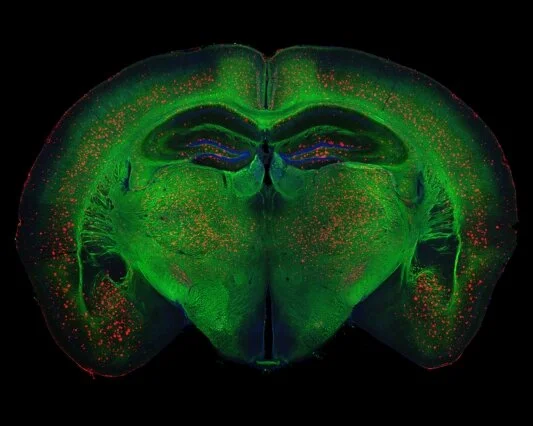Novel Protein Signals Rapid Hippocampal Atrophy in AD
by Fran Lowry for Medscape:The presence of TAR DNA-binding protein 43 (TDP-43) in the hippocampus on postmortem examination is associated with increased rates of hippocampal atrophy in patients with Alzheimer's disease (AD), new research suggests.This association was greatest in individuals who had an intermediate or high likelihood of having AD (ie, neurofibrillary tangle stages B2 and B3), but not in those with a low likelihood (neurofibrillary tangle stage B1) of having AD.Moreover, increased rates of TDP-43–associated hippocampal atrophy could be detected at least 10 years before death.The findings were published online September 11 in Lancet Neurology."This is the first time in the history of Alzheimer's that a protein has been shown to correlate with shrinkage of this part of the brain, so TDP-43 could be a target, something we could direct medication towards, perhaps," lead author, Keith Josephs, MD, Mayo Clinic, Rochester, Minnesota, told Medscape Medical News. "It is quite possible that this could be one of the treatments for Alzheimer's in the future."In a longitudinal retrospective study, Dr Josephs and colleagues analyzed postmortem brain tissue of 298 individuals with an AD-spectrum pathologic diagnosis who had undergone head MRI between January 1, 1999, and December 31, 2012.The patients had been recruited into the Mayo Clinic Alzheimer's Disease Research Center, Mayo Clinic Alzheimer's Disease Patient Registry, or the Mayo Clinic Study of Aging.The researchers performed TDP-43 immunohistochemistry and classified individuals as follows: no TDP-43 in the amygdala or hippocampus, TDP-43 restricted to the amygdala, and TDP-43 spreading into the hippocampus.Each individual was also assigned a neurofibrillary tangle stage (B1 to B3), relating to the likelihood of having AD.Hippocampal volume was calculated on all serial MRI scans, and links between TDP-43 and rate of hippocampal atrophy were calculated.Of the 298 patients, 141 showed no TDP-43 in the amygdala or hippocampus, 33 had the protein in the amygdala only, and 124 patients had TDP-43 in the hippocampus.Among patients at high likelihood of having AD, those who had hippocampal TDP-43 had faster rates of hippocampal atrophy compared with those who had TDP-43 in the amygdala only and those with no TDP-43.Their annual volume change was –4.39% (95% confidence interval [CI], –4.82% to –3.95%; P < .0001). In comparison, those who had TDP-43 in the amygdala only had an annual volume change of –3.29% (95% CI, –4.11% to –2.46%; P < .0001) and those without TDP-43 had an annual volume change of –3.11% (–3.54% to –2.68; P < .0001).A similar trend was seen in patients with an intermediate likelihood of having AD (neurofibrillary tangle stage B2). Those who had hippocampal TDP-43 had faster rates of hippocampal atrophy, with an annual volume change of –4.05% (95% CI, –5.09% to –2.99%; P < .0001).Those with TDP-43 in the amygdala only had an annual volume change of –1.78% (95% CI, –3.04% to 0.55%; P = .004), and those with no TDP-43 had an annual volume change of –1.63% (95% CI, –2.43% to –0.83%; P = .0002).Hippocampal TDP-43 was not associated with the rate of hippocampal atrophy in individuals with a low likelihood of having AD (those with neurofibrillary tangle stage B1).The trajectory analysis suggested that increased rates of TDP-43–associated hippocampal atrophy might occur at least 10 years before death.Currently, no clinical trials are targeting TDP-43, but Dr Josephs hopes this will change."Other clinical trials targeting the two other proteins that we see in AD, amyloid and tau, have all failed. No treatment trial has so far shown any benefit when tau and amyloid have been targeted, but no one has targeted TDP-43, so this would certainly be worth a try."Useful Target?"This is an interesting paper that contributes to our understanding of Alzheimer's disease," Keith Fargo, PhD, director of scientific programs at the Alzheimer's Association in Chicago, Illinois, told Medscape Medical News."Time will tell the significance of this protein. It would be great if it would be a useful target, but you can't know based just on the strength of this paper whether it will turn out to be that way or not. But the results of this paper are consistent with the thought that it may potentially be a target for therapeutics for Alzheimer's disease," Dr Fargo said.TDP-43 does seem to be important in several other neurodegenerative diseases as well, such as amyotrophic lateral sclerosis and frontotemporal dementia, Dr Fargo noted."There are lot of things we still don't know about Alzheimer's disease," he said. "Why does one person get it and not another? What could cause people who have amyloid to go on to develop tau, and then go on to develop that neurodegeneration?"This work gives us more information about what is actually causing the loss of brain cells. It opens up new potential targets for treatment and at the very least helps us understand the disease course better."Source: http://wb.md/2wPtmWl

